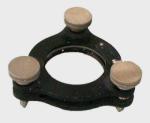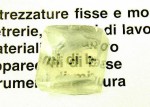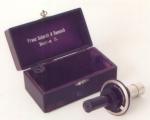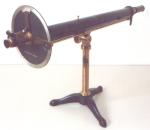|
School University (1), Spano (2) |
 (2) (2)
|
||
|
Function To study the light diffraction. | |||
|
|||
|
Description The slit is obtained between two nickel silver plates with sharp and rectilinear edges. One of them is fixed, the other, sliding between two parallel guides, is controlled by a screw with a friction drum, divided into 50 equal parts, so that the opening is given in hundredths of millimetre. An antagonist spring eliminates any clearance of the screw and internal thread. The diaphragm that holds the split has two perpendicular cones, so that we can dispose the slit horizontally or vertically on its foot. The column allows 12 cm vertical displacements. | |||
 Menu
Menu
|
School University |

|
||
|
Function To study the light interference. | |||
|
|||
|
Description It is an interferometer formed by a glass or quartz plate with parallel surfaces in which multiple reflections take place. | |||
|
School Spano |

|
||
|
Function To see the interference of the light. | |||
|
|||
|
Description Two 100 mm diameter glass disks are closed between two strong circular frames, that we can tighten with three setscrews. One of the disks has plane surfaces, the other has one spherical surface. | |||
|
School Spano |

|
||
|
Function To study the light interference. | |||
|
|||
|
Description The apparatus is used to produce interference fringes. Each black mirror is fixed on a darken brass frame with three screws, that allow the separated adjustment of the two mirrors. The angle is changeable with a micrometric screw, the metallic support has a changeable and variable height. | |||
|
School Spano |

|
||
|
Function To study the light interference. | |||
|
|||
|
Description Two equal rectangular prisms with very narrow angles are coupled on the same screen. Normally they are removed from the same plate and they form one piece set. The line source must be held in two sector plane of the obtuse angle of the bi-prism. The result will be two virtual images. In this way the rays that cross the system behave as if they arrives from two distinct sources, and in the common zone they produce the fringes. | |||
|
School Spano |

|
||
|
Function To show the birefringence. | |||
|
|||
|
Description We place the crystal on a paper sheet, on which a large point is drawn. By looking vertically we see two points, and if we turn the crystal on the plane we will see that one of the two points is at rest while the other turns around the first. | |||
 Menu
Menu
|
School University (1), Spano (2), Castelvì (3) |
 (3) (3)
|
||
|
Function To study the light polarisation. | |||
|
|||
|
Description It is the easiest polarisation apparatus. It is made of two tourmaline plates, that were cut parallelly to the optics axis of the tourmaline crystal. They are fixed in disk-shaped supports which are turning in the handle. A ray that strikes one of the two plates (polariser) is refracted twice; the ordinary ray is absorbed by the plate, while the extraordinary ray appears more or less coloured (green, brown, red) according to the tourmaline. The second plate is used as analyser; when the tourmalines are crossed the field appears dark. When the tourmalines are parallel the field is bright. The polariser and analiser can be exchanged at will: the fact does not change. | |||
 Menu
Menu
|
School University |

|
||
|
Function To study the angle of rotation of an optically active solution. | |||
|
|||
|
Description It is formed by a Nicol prism, a circular vernier and an eyepiece. | |||
|
School University (1), Pellegrini (2) |
 (1) (1)
|
||
|
Function To study the angle of rotation of an optically active solution. | |||
|
|||
|
Description The light beam, generated by a monochromatic source (sodium light), crosses the Nicol prism (polarizer). The light that comes out is linearly polarized and half of it goes directly to the analyzing solution while the other half first crosses a half-wave plate. The two beams, with two different planes of polarization, are then analyzed by another Nicol prism. A circular vernier is placed on the eyepiece. By rotating the analyzer the intensity of the two beams changes. We have two angles where the two half zones are weakly or strongly illuminated, but with the same intensity. | |||
|
School University |

|
||
|
Function To study the light polarisation. | |||
|
|||
|
Description It is made of a mirror placed on the basis, an inclinable crystal plate (polariser) with a device to read the angle, a mobile object holder formed by a ring that encloses a glass disk and an analyser (black mirror). The light emitted by the source passes across the polariser and therefore goes towards the black mirror. A different path can be: source, polariser, mirror on the basis, polariser, black mirror. | |||